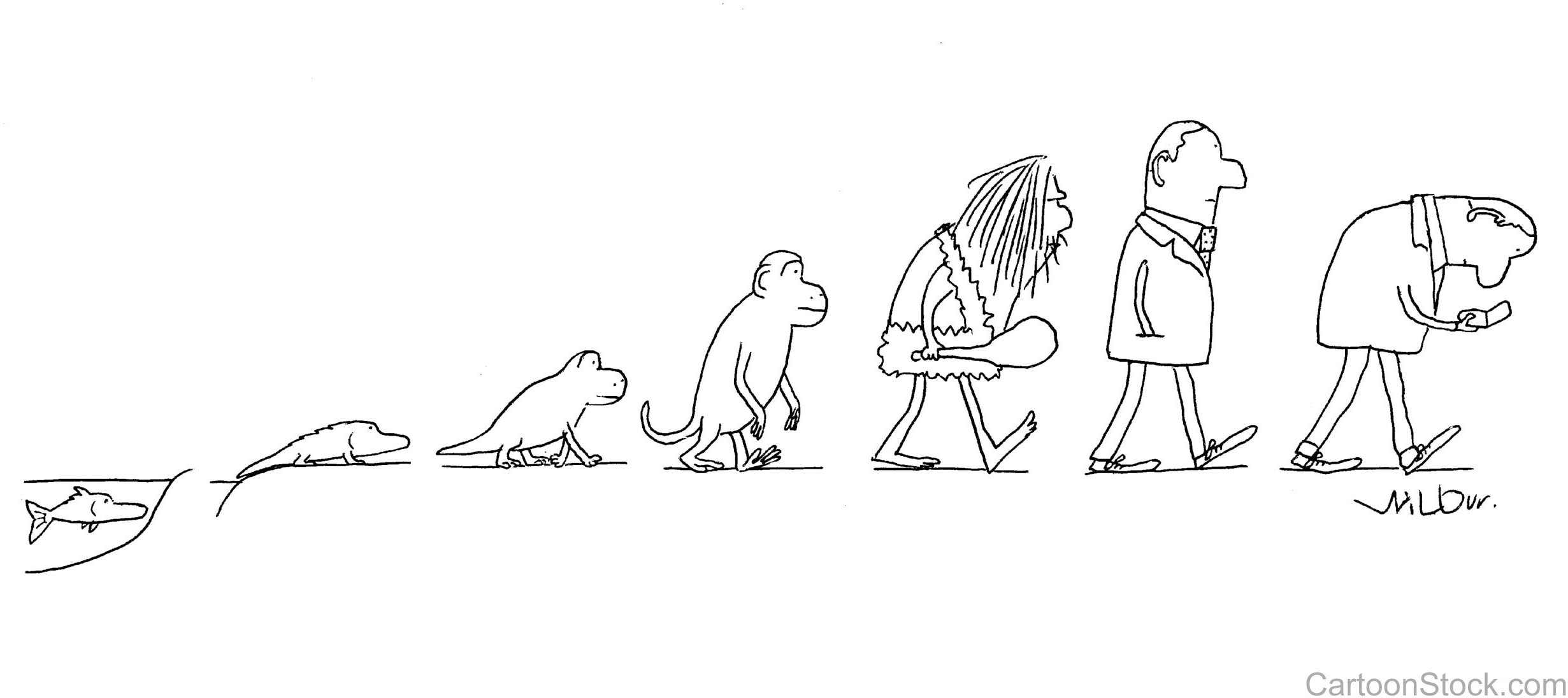LEARNING OBJECTIVES
- Explain how evolution has shaped human behavior and culture.
- Identify some of the most important similarities in human behavior across cultures.
- Identify some of the brain structures and processes that underlie our behavior.
Why do human beings generally live in family groups, assign roles to people on the basis of age and gender, enjoy sharing food, adorn their bodies, classify flora and fauna, and have rites of passage and myths? Evolution may explain such behaviors (Conway & Schaller, 2002).
Evolutionary theory has been around for more than 150 years, ever since Charles Darwin published On the Origin of Species. In his five-and-a-half-year voyage on the Beagle, Darwin discovered how animal and plant species on the Galápagos Islands had changed in specific ways over time in order to adapt to their local physical environments. The theory of evolution he developed from his observations has proved invaluable to understanding why organisms have the physical and social characteristics they do and how they came to have them. The key idea is natural selection: Individuals with certain traits will be better able than others to survive, reproduce, and raise their offspring to the age of viability. These more successful individuals will pass their traits on to their offspring through certain genes. In this process, a species comes to possess its signature traits, or adaptations, that enable effective responses to the physical and social environment.
Darwin himself believed that natural selection operates on behavioral inclinations just as it does on physical characteristics such as size, coloring, or susceptibility to parasites. Today, students of evolution are increasingly convinced that humans’ defining traits are social in nature and are inherited. These include our capacities to learn language, to cooperate, to care for very vulnerable offspring (who carry our genes!), to play, to form groups and tribes, to be wary of those different from us, and even to form beliefs about supernatural forces (e.g., Schaller, Simpson, & Kenrick, 2006; Tomasello, 2019). Scientists are looking through the lens of evolution to explain our capacity for culture, which underlies our ability to store useful knowledge about the physical and social environment (Henrich, 2016).

The sketch depicts the evolution of man in seven stages. The stages, from left to right, shows the following: a fish, a small crocodile, a hominoid primate, Homo habilis, Homo neanderthalensis carrying a club, a man, and a man bent over his mobile phone.
Table 1.1 contains a list of reputed universals. Two things are worth noting about the practices listed in the table aside from their alleged universality. One is that humans share some of these characteristics with other mammals, especially the higher primates. These include facial expressions, dominance and submission, food sharing, group living, greater aggressiveness on the part of males, preference for own kin, and wariness around snakes. The other, even more striking aspect of Table 1.1 is that the important number of universals we share with other animals is quite small.
TABLE 1.1 UNIVERSAL BEHAVIORS, REACTIONS, AND INSTITUTIONS
|
Sex, Gender, and the Family |
|
Copulation normally conducted privately Sexual jealousy Sexual regulation Live in family (or household) Marriage Husband usually older than wife Sexual modesty Division of labor by gender Males more physically aggressive Females do more child care Mother-son incest unthinkable Incest prevention and avoidance Preference for own kin Sex differences in spatial cognition |
|
Social Differentiation |
|
Age statuses Classification of kin Ingroup distinguished from outgroup Division of labor by age Leaders |
|
Social Customs |
|
Baby talk Pretend play Group living Dance Rites of passage Law (rights and obligations) Dominance/submission Taboo foods Feasting Practice to improve skills Body adornment Property Hygienic care Death rites Rituals Magic to sustain and improve life Etiquette Taboo utterances Magic to win love Gossip Toys Decorative art Food sharing |
|
Emotion |
|
Childhood fear of strangers Wariness around snakes Rhythm Facial expressions of fear, anger, disgust, happiness, sadness, and surprise Envy Melody |
|
Cognition |
|
Aesthetics Anthropomorphism of animals Myths Belief in supernatural, religion Medicine Taxonomy Classification of flora and fauna Language Narrative |
|
Source: Compiled by Brown, 1991; appearing in Pinker, 2002. |
Group living contributed to survival in ages past. Groups were required to care for highly vulnerable offspring, to provide protection from predators, and to enable greater success in hunting game and finding foraging areas. The ability to produce and understand language facilitates living in groups because it allows people to convey not only emotions and intentions but also beliefs, attitudes, and complex thoughts to others.
There is strong evidence that infants are born with their brains “prewired” to acquire language, perhaps because of its importance to humans living in groups (Pinker, 1994). Children typically learn language at developmental stages that are almost identical across different cultures. At birth, all infants can produce the full range of possible sounds (phonemes) that exist in the totality of languages spoken anywhere on Earth, and they babble all these sounds in the crib. Language acquisition consists of dropping all the “wrong” phonemes—the ones that are not used by the particular language or languages the child hears as an infant. Thus, children can learn to speak any language depending on where they grow up. They can learn to speak a language perfectly well even if they grow up with deaf parents who never speak at all. Twins can sometimes develop their own unique language in the crib, a language that follows rules of grammar in the same way that formally recognized languages do (Pinker, 1994, 2002). These findings indicate that there are general, inherited propensities to develop grammatical language.
Just as evolution has prepared humans to live together in groups and to communicate in order to promote survival and reproduction, it may also have provided humans with a “theory of mind”—the ability to recognize that other people have beliefs and desires and that understanding others’ beliefs and desires allows us to understand and predict their behavior. Children recognize this before the age of 2 (Asch, 1952; Kuhlmeier, Wynn, & Bloom, 2003; Leslie, 2000; Malle, Moses, & Baldwin, 2001). By the age of 3 or 4, theory of mind is sophisticated enough that children can recognize when other people’s beliefs are false (Wellman, 1990).



The photos show a chimpanzee on left, a man in the middle, and a toddler on the right, who have their mouths wide open, expressing anger.
Some of the most powerful evidence for a biologically based theory of mind comes from studying people who, due to a genetic variation, appear to have extreme difficulty in developing a theory of mind. Such a claim has been made about people with autism, a condition characterized by difficulties in interacting and communicating with others—particularly in relation to mental states like feelings and thoughts. Autistic individuals have difficulty comprehending others’ desires or beliefs and understanding that others’ beliefs might be false (Perner et al., 1989; Tager-Flusberg, 2007). It seems plausible that evolution has provided us with a kind of understanding that is too universally essential to depend on laborious trial-and-error learning. Given the importance of accurately understanding other people’s beliefs and intentions, it would not be surprising that a theory of mind comes prewired.
Evolutionary theory as applied to human behavior is controversial. For example, some people particularly object to the claim that there are biologically based differences between women and men in behaviors related to mate choice. Such notions are controversial in part because they follow a long history of mistaken claims about biological differences that have been used to legitimize and perpetuate male privilege (S. L. Bem, 1993).
Evolutionary claims can also lead people to assume, mistakenly, that biology is destiny—that what we are biologically predisposed to do is what we inevitably will do and perhaps even should do. This claim—that the way things are is the way they should be—is known as the naturalistic fallacy. It has no logical foundation. We are predisposed to do many things that we can overcome. Virtually all human societies are plagued by violence, for example, but the incidence of it over the past few centuries has declined dramatically. The chances of being murdered in various parts of England, for instance, declined from the thirteenth century to the twentieth by factors ranging from 10 to 100 (Pinker, 2011). The percentage of the population killed in wars has declined more or less steadily over the past few thousand years. Civilization can be regarded as the unceasing attempt to modify much of what comes naturally, reducing the extent to which human life, as seventeenth-century philosopher Thomas Hobbes put it, is “poor, nasty, brutish, and short.”
Just because a theory can be misused is no reason to reject the theory in all its aspects. While there is no justification for rejecting evolutionary ideas out of hand, caution about evolutionary claims is essential.
 LOOKING BACK
LOOKING BACKEvolutionary theory informs our understanding of human social behavior just as it informs our understanding of the physical characteristics of plants and animals. The fact that many of our social tendencies are universal—from language to theory of mind to our capacity to cooperate—suggests that they were advantageous to people’s survival in the course of our evolution and are supported by biological processes that emerge early in development. Although misunderstandings and misapplications of evolutionary ideas sometimes make people suspicious of them, evolution offers a rich framework for thinking about the social tendencies we all share. Social neuroscience is helping us understand what happens in the brain in different social situations.
Social Neuroscience
Evolutionary approaches to social behavior alert us to the fact that everything humans do or think involves biological processes in the brain and body that have been shaped by natural selection. In recent years, social psychologists have begun to examine the biological grounding for behavior: the brain. This new field is called social neuroscience.
The brain may be the most complex living system in the universe, with 100 billion neurons organized into at least 50 distinct regions, and with each neuron connecting on average to 15,000 other neurons. One of the chief tools that social psychologists use to understand the brain’s role in social behavior is a technology known as functional magnetic resonance imaging (fMRI). When a person is talking with another person, making a moral judgment, or experiencing fear or outrage, blood flows to the areas of the brain that are activated. Scientists can take a picture of the brain that detects this blood flow, thus showing which brain regions are involved in the social behavior of interest.
As social neuroscience has matured, it has revealed just how social the human brain is (Lieberman, 2013). Older regions of the brain that we share with other mammals appear to be involved in nonconscious, automatic reactions to our social environment. For example, the amygdala, an almond-shaped region of the brain colored yellow in Figure 1.5, is involved in gut feelings, especially those of a fearful nature, about salient stimuli we encounter in the environment—strangers, threatening images, people from adversarial groups (W. A. Cunningham & Brosch, 2012; Ochsner & Lieberman, 2001). Near the amygdala is another old, mammalian region of the brain known as the nucleus accumbens, colored red in Figure 1.5. This area is rich with receptors for dopamine, the chemical associated with reward. The area projects to the prefrontal cortex at the front of the brain, where we process complex thoughts and emotions. The nucleus accumbens is thought of as the brain’s “reward circuit.” It signals to the individual in quick, automatic fashion what is rewarding in the environment, be it the smile of a stranger, the opportunity to have delicious ice cream, or support from a friend (Haber & Knutson, 2010).
More information
The sectional view of the brain highlights the internal parts of the brain. The front side of the brain is labeled as Prefrontal cortex, represented in pink, a region in the middle is labeled as nucleus accumbens, represented in red, and a region below and to the right of the nucleus accumbens is labeled as the amygdala, highlighted in yellow.
What is unique about the human brain when compared with the brains of other mammals is the size of our neocortex, which consists of the layers of neurons on top of older regions of the brain, such as the amygdala. Significant areas of the neocortex are involved in reasoning, abstract thought, and memory. Some of these regions are particularly involved in social behavior. For example, some regions are involved in self-awareness (D. D. Wagner, Haxby, & Heatherton, 2012) and moral judgment concerning what is right and wrong and whether to punish or forgive (J. D. Greene, 2014). There is also an empathy network of the neocortex that enables us to experience the feelings of others (Singer & Klimecki, 2014) and a “mentalizing network” that enables us to understand other people’s mental states, intentions, desires, and beliefs (Lieberman, 2007, 2013). People feel dramatically different when they are around people who accept them versus those who reject or shun them. It’s not surprising that acceptance and rejection activate much different regions of the brain, known as the social safety and social alarm networks (Eisenberger, 2016; Muscatell & Eisenberger, 2012).
These advances by social neuroscientists set the stage for answers to intriguing questions, such as why gaining power so often leads to its abuse or why people experience a warm glow when they cooperate with others. These discoveries have also provided a window into the development of social behavior by tracing physical changes in the brain. For example, it turns out that a region of the brain that alerts people to danger is poorly developed until early adulthood (Decety & Michalska, 2010). This late development of an important brain region may help explain why adolescents take greater risks (in how they drive, for instance) than people in their mid 20s and beyond.
More information
The pencil sketch depicts a woman sitting on a couch and a man standing beside her, carrying a folder. A boy stands in front of them.
Neuroscience not only tells us which areas of the brain function most when certain kinds of activities are taking place. It also informs us about how the brain, the mind, and behavior function as a unit and how social factors influence each of these components at the same time.